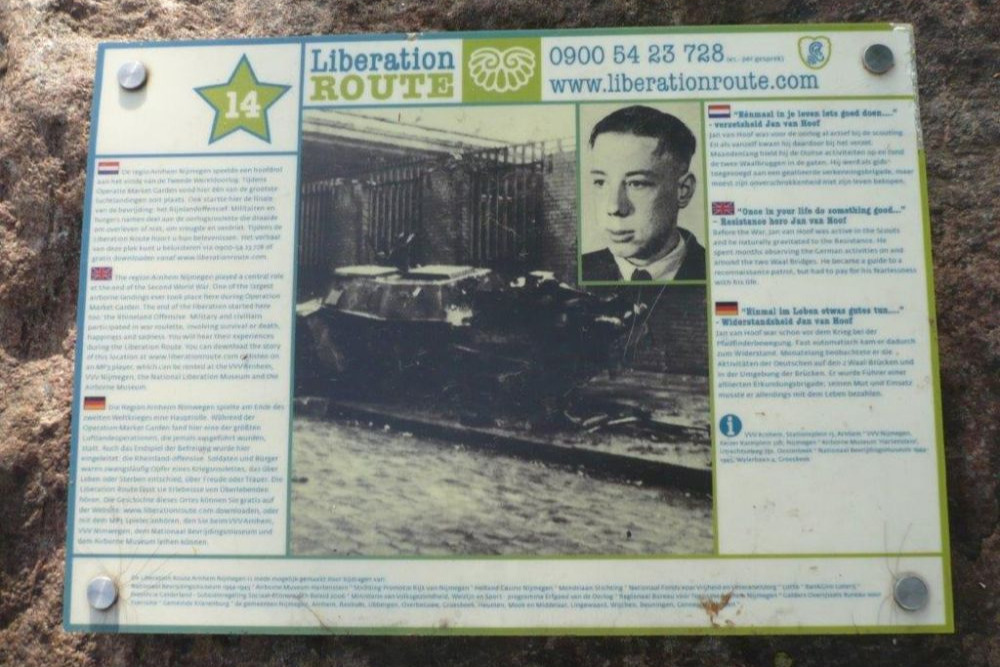Liberation Route Marker 014
Liberation Route Europe is a certified Cultural Route of the Council of Europe. With hundreds of sites and stories in nine European countries, the route links the main regions along the advance of the Allied Forces in 1943-1945.
The entire route consists of themed routes that can be travelled by by hiking, walking, cycling and car. These routes pass numerous historical and interesting sites and tell stories from a multitude of perspectives that were important in the final phase of World War II.
Many routes feature listening spots, offering the opportunity to listen to a historical story at a location. In addition, many ‘Vectors of Memory’ have been placed, indicating that the passer-by is on one of the Liberation Routes.
The routes can be found on the Liberation Route Europe website or in the app through which many stories can also be listened to.
'Once in your life do something good...' - Jan van Hoof
Before the War, Jan van Hoof was active in the Scouts and he naturally gravitated to the Resistance. He spent months observing the German activities on and around the two Waal Bridges. He became a guide to a reconnaissance patrol, but had to pay for his fearlessness with his life.
On September 20 1944, there was heavy fighting around the bridges in Nijmegen. The situation for the Germans worsened as the Americans and British steadily gained ground. SS Colonel Heinz Harmel of the 10th SS Panzer 'Frinsberg' division ordered the road bridge to be blown up, but the charges did not explode. Some of the explosives were defective, and the Americans had succeeded in cutting the fuses to others. Other fuses had already been cut on September 18 by the 22 year-old Dutch student Jan van Hoof. Jan van Hoof, a member of the Scouts who was in the resistance, was arrested and executed by the Germans on September 19, as he was guiding a British armoured vehicle through the City. His role in the saving and capture of the bridge was at first disputed, but after the war he was posthumously decorated by both the Netherlands and the United States. Since the Second World War, many scouting groups have been named after him.
Jan van Hoof, who was first interred in the cemetery on the Daalseweg, was later reburied in an official war grave, and now lies in the Erekerkhof cemetery, on the Weg door Jonkerbos. The date of Jan van Hoof's death is reported on his gravestone as 22 - 9 - 1944 instead of 19 - 9 - 1944.
Audiospot - 'Once in your life do something good...' - Jan van Hoof
Do you have more information about this location? Inform us!
Source
- Text: TracesOfWar & Liberationroute.com
- Photos: Jimmy Hilgen (1, 3), Arie van Wijngaarden (2)
Related books
Nearby
Museum
Point of interest
- Remains Church Building of the Carmelite Monastery Nijmegen - Nijmegen
- Fire Border 024 Nijmegen - Nijmegen
- White Stripe Nijmegen - Nijmegen
Monument
- Memorial Belgian Prisoners-of-War - Nijmegen
- Memorial Titus Brandsma - Nijmegen
- Memorial Civilian Victims Nijmegen - Nijmegen
Cemetery
- Dutch War Grave Nijmegen - Nijmegen
- Commonwealth War Graves Rustoord Cemetery Nijmegen - Nijmegen
- Jewish War Graves Nijmegen - Nijmegen
Remembrance Stone
- Remembrance Stone Jan van Hoof - Nijmegen
- Stumbling Stones Begijnenstraat 11 - Nijmegen
- Stumbling Stones Stikke Hezelstraat 54 (formerly 46) - Nijmegen

































